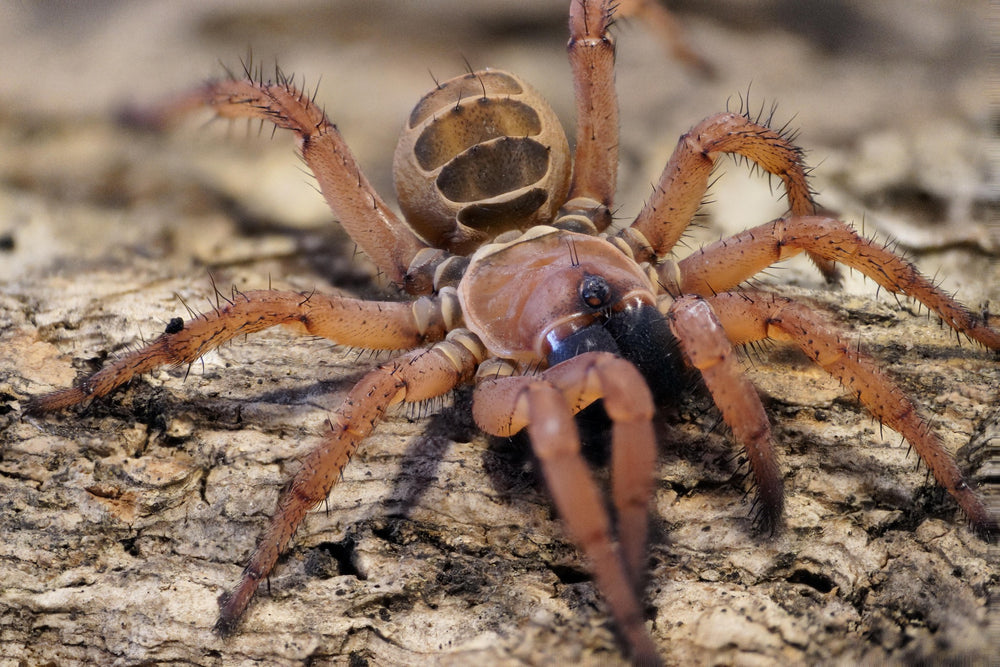Theraphosa apophysis (Goliath Pink Foot) 1" | 4-5" MALE
- Live Arrival Guarantee
- Live Animals Ship FedEx Priority Overnight (Mon-Weds)
- Low stock - 6 items left
- Inventory on the way
One of the largest tarantulas on Earth, the Pinkfoot Goliath tarantula, Theraphosa apophysis Tinter is the lesser-known cousin of the Goliath Bird Eating Tarantula and an absolute must-have for anyone that likes their spiders on the large side. T. apophysis has a more stunning coloration as juveniles and has narrower legs than other members of the genus. The abdomen and carapace are velvet-clad in short hairs that are rusty brown but can take on a metallic pink sheen, especially in juveniles prior to 5” size. Juveniles have vibrant pink to pale salmon-orange tone tarsi and metatarsi, which almost have a gradient-like appearance radiating from the body. Spiderlings through large juveniles also sport zebra-like stripes of pink on the legs and a pink "V" pattern on the carapace. The urticating hairs and cactus spine-like setae along the legs are huge and pale pink, giving the spider an electric vibrance. When T. apophysis reaches a 5" diagonal leg span and beyond, the pink disappears and the whole tarantula is mostly red-brown in coloration.
This tarantula is native to the tropical rainforest understories of Venezuela. T. apophysis is a robust terrestrial that constructs its burrows beneath logs and debris, awaiting prey at their hide entrances at night. They have a medium to fast growth rate, with spiderlings attaining a four-inch diagonal leg span within one year. T. apophysis is best suited for experienced to advanced keepers as they are skittish as juveniles but secluded and defensive as adults and notorious for kicking urticating hairs. Their urticating hairs are even more irritating than other members of the genus (Theraphosa spp. are already notorious for having nasty urticating hairs). This species is also even more apt to kick hairs than any other members of the Theraphosa, which is saying a lot. Do not handle this tarantula, and wear personal protective gear when cleaning their cages or maneuvering it.
T. apophysis has a strong feeding response and will readily attack large prey. For adults, pre-killed mice, birds, and lizards can be occasionally offered, especially for gravid females. Even though these tarantulas likely regularly predate vertebrates in the wild, do not feed them live vertebrates as they can injure or kill the tarantula.
A large, terrestrial enclosure with more width than height is needed for mature T. apophysis. Reduced height is crucial for preventing large tarantulas from climbing too high and risking a mortal fall injury. It is also imperative not to use mesh anywhere on the lid, and the lid should be latched, weighted, and/or well-secured, as these huge tarantulas are very strong and easily nudge open tank lids.
Provide adults with a 4" deep layer of organic, humusy substrate. T. apophysis is less humidity and moisture-sensitive than other members of the genus, so the substrate should be maintained as mostly dry with periodic light mistings. A well-secured cork hide with a cavity or cave beneath works for adults. If you are looking for a gorgeous gigantic arachnid, you cannot go wrong with the stunning Pinkfoot Goliath Bird Eating Tarantula!

Info on our shipping policy can be found on our T&C page.







